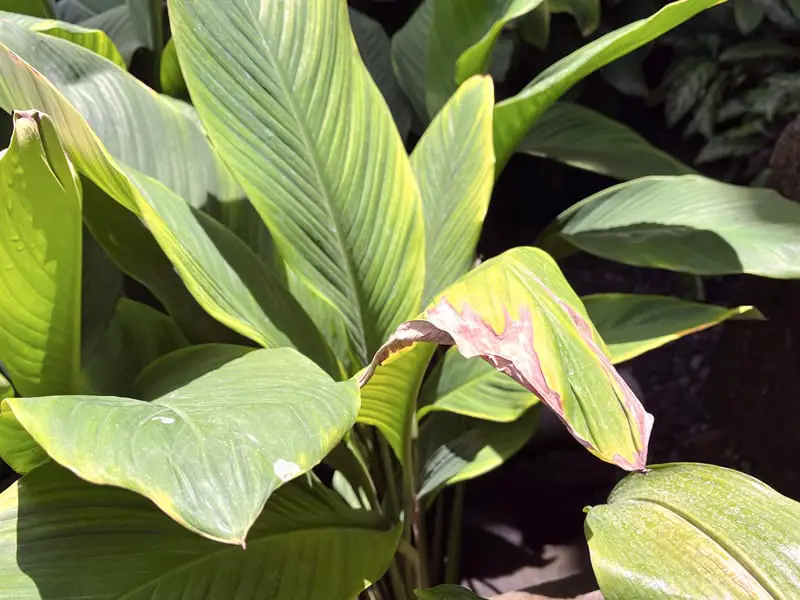
Do you plan to move your peace lily (Spathiphyllum spp.) outside this summer? Or are you planning to let it grow outdoors? Well, the big question is whether or not it will survive.
Generally, Peace Lilies can grow outdoors year-round in USDA plant hardiness zones 10 to 12. However, they need adequate moisture, shade from direct sunlight, and protection from pest infestation.
In this article, we’ll discuss in detail how to provide the best conditions for your peace lily outdoors and how to care for it to ensure its survival.
Let’s get started!
Can Peace Lily Survive Outdoors?
In nature, Peace Lilies are found in the understory of tropical rainforests. They grow best in shaded areas with warm temperatures, high humidity, and plenty of moisture.
This is why peace lilies are often grown as indoor plants in the US as it can be challenging to replicate these conditions outdoors.

In fact, Peace Lily can only be planted outdoors in USDA plant hardiness zones 10 to 12, including Florida, Hawaii, and parts of Southern California and Texas. If you live outside these states, your best bet is to grow Peace Lily in a pot.
You can move your potted peace lilies outside during summer, but you should bring them back inside once nighttime temperatures drop below 60°F (15°C) to avoid frost damage.
Providing Care for Outdoor Peace Lilies
Now that you know whether or not you can grow Peace Lily outdoors, let’s take a look at how to provide the best care for your plant.
Here are a few tips:
Choose a Spot with Bright, Indirect Sunlight
While Peace Lilies can tolerate low-light conditions, they will grow best and bloom in bright, indirect sunlight.
If you live in a hot climate, make sure to provide plenty of shade from direct sunlight as the leaves can scorch in direct sun.

Ideally, Peace Lily should be grown under the dappled shade of trees, in shady spots near a building, or on a porch to provide bright, indirect sunlight.
Place the plant in an east- or south-facing location to benefit from the morning sun while avoiding the harsh afternoon sun.
Prepare Rich, Well-draining Soil
Similar to their indoor counterparts, outdoor Peace Lilies need rich, well-draining soil to thrive. They do not like to sit in waterlogged soil as this can lead to root rot.
To prepare the soil, mix organic matter such as compost or peat moss into the top 6 to 8 inches of your planting bed. You can also add perlite or vermiculite to improve drainage and a handful of bonemeal to provide extra nutrients.
During the summer months, Peace Lilies will benefit from a light application of fertilizer every 4 to 6 weeks.
Use a balanced fertilizer such as 10-10-10 or 20-20-20 to provide the right mix of nutrients and encourage blooming.
Dilute the fertilizer to half the recommended strength and apply it to the soil around the base of the plant. Be sure not to get any fertilizer on the leaves as this can burn them.
Regular Watering Schedule
Since outdoor Peace Lilies are exposed to wind, sun, and heat, they lose moisture via evaporation faster than indoor plants. This is why you need to water them more often.
Generally, you should water your plant twice a week and ensure that the top 6 inches of the soil stay moist. During the hottest months, you may need to water your Peace Lily 2 to 3 times per week.
As peace lilies are sensitive to chlorine, it is recommended that they are watered with filtered or rainwater instead of tap water.
Use lukewarm water and avoid getting the leaves wet as this can encourage fungal growth.
Also read: Watering Plants in the Sun – Is it Safe?
Pruning Spent Flowers
While the flowers of peace lilies are beautiful, they only last for a month. Once the flowers start to fade and wilt, you should prune them off.
To prune the flowers, cut the stem off at the base of the plant using a sharp knife or pruning shears. Do not make the same mistake as me and try to pull the flowers off as this can damage the stem.
Generally, a peace lily will bloom twice a year, during the summer and fall. However, if it doesn’t bloom, it could be due to several reasons, such as insufficient light, incorrect temperature, lack of nutrients, or improper watering.
You can this article for more tips on how to get your peace lily to bloom.
Divide Peace Lilies Annually
As Peace Lilies are fast-growing plants, they will need to be divided every year or two to prevent them from becoming overcrowded.
Overcrowded plants have to compete for water and nutrients, which can stunt their growth. Dividing the plants into smaller sections reduces this competition and stimulates new growth as well as more vigorous blooming.
To divide your plant, simply dig up the entire root ball and gently pull it apart into smaller sections. Each section should have at least 3 to 4 leaves and its own root system.
After dividing the plants, you can either repot them into individual pots or plant them in different areas of your garden.
If you plant them outdoors, make sure they are at least 3 feet apart (1 meter) to give the plants plenty of room to grow and ensure proper air circulation. This will enable the plants to perform optimal photosynthesis while promoting healthy growth.
Water the plants well after replanting and keep them moist until they become established.
When to Bring Peace Lilies Indoors
Although peace lilies are tropical plants that can tolerate a wide range of conditions, they are not frost-tolerant.
If you live in an area where the temperature dips below 60°F (15.5°C) in the winter, it’s best to bring your plant indoors.
To transition your plant indoors, gradually acclimate it to the lower light levels by placing it in a shady spot outdoors for a week or two.
After that, you can move it into a bright, indirect spot indoors. Keep in mind that peace lilies prefer warm temperatures, so try to keep the room between 70°F and 85°F (21-29°C).
Once your plant is indoors, you can reduce the watering frequency as it will lose moisture slower than when it was outdoors.
Fence Off Outdoor Peace Lilies (Optional)
If you have pets, you may want to consider fencing off your peace lily to prevent them from coming into contact with or eating the plant.
According to the ASPCA, peace lilies are toxic to dogs and cats if ingested. The toxicity level is moderate, so symptoms are usually mild and include mouth, tongue, and lips irritation, excessive drooling, vomiting, and difficulty swallowing.
If you suspect that your pet has eaten a peace lily, it’s best to contact your veterinarian as soon as possible.
To be on the safe side, it’s best to fence off your plant or keep it out of reach of pets. A simple wire fence will do the trick.
Frequent Problems with Outdoor Peace Lily
Even when you already provide the ideal environment, your outdoor Peace Lily can still experience some problems, including pest infestation and root rot.
In this section, we’ll discuss each of these problems in detail and provide tips on how to fix them.
Dealing with Pests Infestations
Outdoor Peace Lilies are also susceptible to pests infestations, such as spider mites, mealybugs, or scale insects. These pests will suck the sap from the leaves, leading to yellowing and wilting.
Identifying their presence early is key to preventing an infestation from taking over your plant. Check the underside of the leaves regularly for signs of pests, such as webbing, white residue, or small bumps.
If you see any pests, wipe them off with a damp cloth and dispose of them immediately. You can also use insecticidal soap or horticultural oil, to get rid of them.
Releasing ladybugs in your garden can also help control pests as they feed on aphids, mealybugs, and other small insects.
However, if the infestation is severe, you must trim off the affected leaves and stems. Destroy the affected plant parts to prevent the pests from spreading.
Avoid Root Rot Disease
One of the most common problems Peace Lily growers face is Cylindrocladium root rot. This fungal disease thrives in wet, poorly drained soil and can quickly kill your plant.
To prevent root rot, make sure to plant your Peace Lily in well-draining soil and water it only when the top few inches of the soil are dry. Avoid splashing water on the leaves as this can spread the disease.
A yellowing leaf or stunted growth could indicate root rot. Dig up the plant and examine the roots.
If they are brown and mushy, then your plant has root rot. You can try treating it with a fungicide and replanting it in well-draining soil.
Frequently Asked Questions about Growing Peace Lily Outdoors
How Tall Do Peace Lilies Grow Outdoors?
Under ideal conditions, peace lilies typically grow to be between 2-3 feet (60-90 cm) tall. However, some cultivars such as the Spathiphyllum ‘Sensation’ can grow up to 6 feet (1.8 m) tall.
If you prefer a smaller plant, you can choose a dwarf cultivar, such as Spathiphyllum Little Angel, Patricia, or Piccolino which only grows to be about 1 foot (30 cm) tall.
Another tip to keep your peace lily small is by cutting back the outer leaves and dividing the plant once a year
Can peace lilies tolerate full sun?
Peace Lily can’t tolerate full sun and will scorch, wilt and die if exposed to it for too long. That’s why it’s best to grow them in bright, indirect, or filtered light.

If you want to grow it outdoors, choose a spot like under a tree where it will get dappled sunlight throughout the day.
Are peace lilies frost tolerant?
Peace Lily is not frost-tolerant and will die if exposed to temperatures below 50°F (10°C). If you live in an area with a cold winter, it’s best to grow your plant indoors or in a greenhouse.
If you grow it outdoors, make sure to bring it indoors before the first frost hits.

